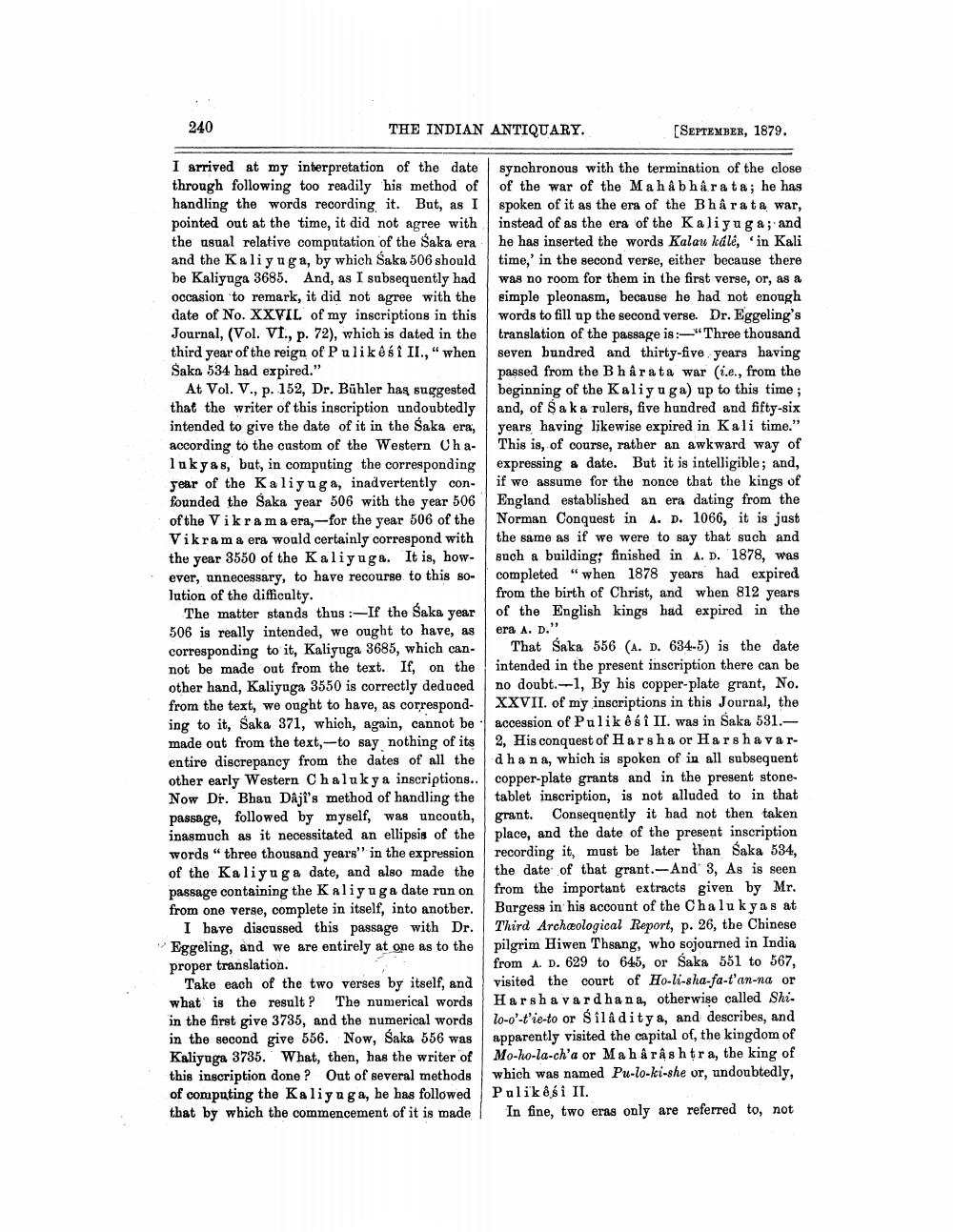________________
240
THE INDIAN ANTIQUARY.
[SEPTEMBER, 1879.
I arrived at my interpretation of the date synchronous with the termination of the close through following too readily his method of of the war of the Mahabharata; he has handling the words recording, it. But, as I spoken of it as the era of the Bharata war, pointed out at the time, it did not agree with instead of as the era of the Kaliyuga; and the usual relative computation of the Saka era he has inserted the words Kalau kálė, 'in Kali and the Kaliyuga, by which Saka 506 should time,' in the second verse, either because there be Kaliyuga 3685. And, as I subsequently had was no room for them in the first verse, or, as a occasion to remark, it did not agree with the simple pleonasm, because he had not enough date of No. XXVIL of my inscriptions in this words to fill up the second verse. Dr. Eggeling's Journal, (Vol. VI., p. 72), which is dated in the translation of the passage is :-"Three thousand third year of the reign of Pulikasi II.," when seven bundred and thirty-five years having Saka 534 had expired."
passed from the Bharata war (i.e., from the At Vol. V., p. 152, Dr. Bühler has suggested beginning of the Kaliyuga) up to this time; that the writer of this inscription undoubtedly and, of Saka rulers, five hundred and fifty-six intended to give the date of it in the Saka era, years having likewise expired in Kali time." according to the custom of the Western Cha- This is, of course, rather an awkward way of luk yas, but, in computing the corresponding expressing a date. But it is intelligible; and, year of the Kaliyuga, inadvertently con- if we assume for the nonce that the kings of founded the Saka year 506 with the year 506 England established an era dating from the of the Vikrama era, -for the year 506 of the Norman Conquest in A. D. 1066, it is just Vikrama era would certainly correspond with the same as if we were to say that such and the year 3550 of the Kaliyuga. It is, how- such a building; finished in A. D. '1878, was ever, unnecessary, to have recourse to this so- completed “when 1878 years had expired lution of the difficulty.
from the birth of Christ, and when 812 years The matter stands thus :-If the Saka year of the English kings had expired in the 506 is really intended, we ought to have, as era A. D." corresponding to it, Kaliyuga 3685, which can- That Saka 556 (A. D. 634-5) is the date not be made out from the text. If, on the intended in the present inscription there can be other hand, Kaliyuga 3550 is correctly deduced no doubt. -1, By his copper-plate grant, No. from the text, we ought to have, as correspond- XXVII. of my inscriptions in this Journal, the ing to it, Saka 371, which, again, cannot be accession of Palik esi II. was in Saka 531.made out from the text,--to say nothing of its 2, His conquest of Harsha or Harshavarentire discrepancy from the dates of all the dhana, which is spoken of in all subsequent other early Western Chaluky a inscriptions.. copper-plate grants and in the present stoneNow Dr. Bhau Daji's method of handling the tablet inscription, is not alluded to in that passage, followed by myself, was uncouth, grant. Consequently it had not then taken inasmuch as it necessitated an ellipsis of the | place, and the date of the present inscription words "three thousand years" in the expression recording it, must be later than Saka 534, of the Kaliyuga date, and also made the the date of that grant.-And 3, As is seen passage containing the Kaliyuga date run on from the important extracts given by Mr. from one verse, complete in itself, into another. Burgess in his account of the Chalu kyas at
I have discussed this passage with Dr. Third Archaeological Report, p. 26, the Chinese Eggeling, and we are entirely at one as to the pilgrim Hiwen Thsang, who sojourned in India proper translation.
from A. D. 629 to 645, or Saka 551 to 567, Take each of the two verses by itself, and visited the court of Ho-li-sha-fa-t'an-na or what is the result? The numerical words Harsha vardhana, otherwise called Shiin the first give 3735, and the numerical words lo-o'-t'ie-to or Siladitya, and describes, and in the second give 556. Now, Saka 556 was apparently visited the capital of the kingdom of Kaliyaga 3735. What, then, has the writer of Mo-ho-la-ch'a or Maha râshtra, the king of this inscription done ? Out of several methods which was named Pu-lo-ki-she or, undoubtedly, of computing the Kaliyuga, he has followed Palikesi II. that by which the commencement of it is made! In fine, two eras only are referred to, not




